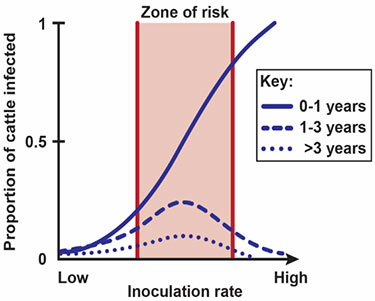
November 2017
A Possible Fallacy of Anaplasmosis Control: The Concept of "Endemic Stability"
By Dr. Gregg Hanzlicek

|
||
| Figure 1. When infection rates of all ages of animals are very low (left side of the graph) endemic stability can occur. When infection rates are very high (right side of the graph) then only those animals from birth to 1 year of age are likely to become infected, thus resulting in endemic stability. When the infection rate is moderate (graph red area) herds are most likely to be unstable. |
Most practitioners and their producers would agree that Anaplasmosis control at the herd level is very difficult.
A common control recommendation suggests that Anaplasma marginale positive herds residing in endemic areas let their herds become “endemically stabile”.
The definition for endemic stability is: an anaplasmosis positive herd where the number of animals experiencing clinical signs is minimal.
Australian researchers recently completed a multi-year study examining anaplasmosis positive herds to address the concept of stability.1 Their study resulted in some very interesting concepts.
There are two primary ways for herds to experience endemic stability. One, is to reduce the number of new infections to a very low level. The fewer number of animals becoming initially infected with A. marginale, logically the fewer the number of animals that will express clinical signs. The second way stability can occur is when a very large number of animals each year are infected. In this scenario, logically, after a few years of a high infectivity rate (force of infection), only young animals will be able to become infected, Figure 1. Young animals (usually less than 2 years of age) rarely express clinical signs when infected. The research indicated that when the force of infection is not small or great, but moderate, the risk of clinical outbreaks is greatest.
Because this is a vector-borne disease (can also be iatrogenic) and if the results of this research are correct, then the amount of vectors and disease transmission must be consistently either low or high every/most years for the herd to become endemically stable. That this consistency is likely required, but biologically not likely (tick and fly populations are not usually stable from year to year), may explain why endemic herds periodically experience clinical anaplasmosis including dead adults.
The KSVDL every year investigates herds that have been infected for many, many years and are in an endemic area, have not observed any clinical signs for years, and now this year have experienced anaplasmosis death losses. One of the plausible explanations for this is the concept explained above about the force of infection not being consistent across years. Another plausible explanation is that a new more virulent strain has been introduced into the herd. We now know that individual animals can carry more than one A. marginale strain at a time—the significance of this is unknown.
The concept of a herd maintaining endemic stability consistently may not be possible given the biology of transmission. It might make sense that practitioners and producers use other tools available to reduce clinical signs, including the legal use of chlortetracycline in feed or mineral, the use of the experimental A. marginale vaccine, and practicing appropriate biosecurity through pre-purchase A. marginale blood tests.
1Is endemic stability of tick-borne disease in cattle a useful concept?Trends in Parasitology, Vol. 28, Issue 3, 2012, pages 85-89
Nicholas N. Jonsson, Russell E. Bock, et al.
An Injection Site Reaction: Post-Rabies Vaccination Panniculitis in a Toy Poodle
Return to Index